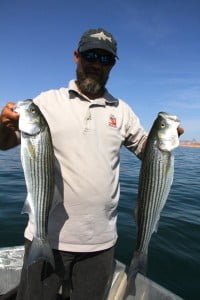 Dave Sellers, expert fly fishermen from California, found stripers using flies while anglers using conventional tackle struggled. The technique that all can use is tying a fly on a spinning rod and trolling it along the surface to catch plankton eating stripers.
Dave Sellers, expert fly fishermen from California, found stripers using flies while anglers using conventional tackle struggled. The technique that all can use is tying a fly on a spinning rod and trolling it along the surface to catch plankton eating stripers.
Lake Powell Fish Report – June 24, 2015
Lake Elevation: 3611
Water Temperature 78 – 83 F
Slurps, Slurps, Slurps!
Fishing is very exciting now with striped bass popping to the top over the length of the lake. Catching is sometimes a different story so I am dedicating this report to help you catch more of the fish seen surfacing.
When: Stripers are looking for three square meals a day. The only thing on the menu is small shad that live close to the surface while searching for plankton to eat. The first daytime feeding event occurs at first light and lasts until the shade is gone. The early morning period can be cancelled if the morning breeze roughs up the water surface making it difficult for stripers to see the tiny shad in the rolling waves.
The next feeding period is from 9-11 AM (MST). If wind is a factor early then the combined first and second feeding period will begin as soon as the wind lays down allowing stripers to come up.
The last surface feeding event begins at 4 PM (MST) and continues until dark. This is the best and most consistent feeding period unless afternoon wind spoils the party.
Where: Most of the action seen lately is in the main channel and main canyon areas in clear water. As water clarity improves in the next few weeks the northern lake will be the center of activity. Today the best area is from Bullfrog downstream to Padre Bay.
How: Slurps are quick but numerous. When the slurp erupts it is critical to quickly get in casting range. How close is different for each individual depending on how far you can cast with your rod and the lure used. Regardless of the distance when in range make the first cast count. There may not be time for a second chance. Ideally the first cast will land 2 feet in front of the leading fish in the skirmish line. The natural tendency is to then reel fast through the school. The better approach is to slow down realizing that small shad are not fast swimmers. Give the striper time to eat a shad and then come to find your larger lure that may be more enticing than the standard ¾ inch skinny shad.
What: Many differ small lures are working now but it may be that one lure worked great yesterday but not so good today. So be prepared. The list, in no particular order, includes size 65 lucky Craft ghost colored pointers, small Revenge spoons with chartreuse back, small Kastmaster lures (1/4 to ½ ounce), other similar size spoons, low profile surface lures (Ima Skimmers), small shad colored plastic grubs (1/8 ounce), crappie lures, swim baits, etc. Really, any small lure will work at the right time.
Tips: Retrieve the lure slow and steady through a surfacing school.
Immediately after a school leaves the surface, cast to the last known location and let the spoon or grub fall to a depth of 12-20 feet. Then slowly retrieve the lure back toward the boat. More than half the time the school of stripers will follow your lure. Watch the zone at the edge of visibility (12 feet) to see the lure come back into view. When stripers are seen following, drop the lure out of sight then jig it a time or two to catch more fish.
Larger stripers cannot compete in the warm surface water with the small ones. To target larger fish, troll or cast near main channel slick rock points with a 45 degree slope where bottom depth is 25 feet. Bait is working for bigger fish in deeper water. Catch rate is slower but size is significantly larger (3-6 pounds) for bait-caught fish.
By the way, smallmouth bass fishing remains extremely good on the same gently sloping slick rock walls of the main channel from Padre to Bullfrog.
The best bass experience is had by throwing surface lures followed by senkos to the recently covered weedy pockets near deep water at first light in the morning. That is where big largemouth bass are now lurking.
There is always a new adventure while fishing Lake Powell.
—
Quality of life is measured by amount of time spent fishing. Wayne Gustaveson
Slurps, Slurps, Slurps!
Fishing is very exciting now with striped bass popping to the top over the length of the lake. Catching is sometimes a different story so I am dedicating this report to help you catch more of the fish seen surfacing.
When: Stripers are looking for three square meals a day. The only thing on the menu is small shad that live close to the surface while searching for plankton to eat. The first daytime feeding event occurs at first light and lasts until the shade is gone. The early morning period can be cancelled if the morning breeze roughs up the water surface making it difficult for stripers to see the tiny shad in the rolling waves.
The next feeding period is from 9-11 AM (MST). If wind is a factor early then the combined first and second feeding period will begin as soon as the wind lays down allowing stripers to come up.
The last surface feeding event begins at 4 PM (MST) and continues until dark. This is the best and most consistent feeding period unless afternoon wind spoils the party.
Where: Most of the action seen lately is in the main channel and main canyon areas in clear water. As water clarity improves in the next few weeks the northern lake will be the center of activity. Today the best area is from Bullfrog downstream to Padre Bay.
How: Slurps are quick but numerous. When the slurp erupts it is critical to quickly get in casting range. How close is different for each individual depending on how far you can cast with your rod and the lure used. Regardless of the distance when in range make the first cast count. There may not be time for a second chance. Ideally the first cast will land 2 feet in front of the leading fish in the skirmish line. The natural tendency is to then reel fast through the school. The better approach is to slow down realizing that small shad are not fast swimmers. Give the striper time to eat a shad and then come to find your larger lure that may be more enticing than the standard ¾ inch skinny shad.
What: Many differ small lures are working now but it may be that one lure worked great yesterday but not so good today. So be prepared. The list, in no particular order, includes size 65 lucky Craft ghost colored pointers, small Revenge spoons with chartreuse back, small Kastmaster lures (1/4 to ½ ounce), other similar size spoons, low profile surface lures (Ima Skimmers), small shad colored plastic grubs (1/8 ounce), crappie lures, swim baits, etc. Really, any small lure will work at the right time.
Tips: Retrieve the lure slow and steady through a surfacing school.
Immediately after a school leaves the surface, cast to the last known location and let the spoon or grub fall to a depth of 12-20 feet. Then slowly retrieve the lure back toward the boat. More than half the time the school of stripers will follow your lure. Watch the zone at the edge of visibility (12 feet) to see the lure come back into view. When stripers are seen following, drop the lure out of sight then jig it a time or two to catch more fish.
Larger stripers cannot compete in the warm surface water with the small ones. To target larger fish, troll or cast near main channel slick rock points with a 45 degree slope where bottom depth is 25 feet. Bait is working for bigger fish in deeper water. Catch rate is slower but size is significantly larger (3-6 pounds) for bait-caught fish.
By the way, smallmouth bass fishing remains extremely good on the same gently sloping slick rock walls of the main channel from Padre to Bullfrog.
The best bass experience is had by throwing surface lures followed by senkos to the recently covered weedy pockets near deep water at first light in the morning. That is where big largemouth bass are now lurking.
There is always a new adventure while fishing Lake Powell.
—
Quality of life is measured by amount of time spent fishing. Wayne Gustaveson



